Citizen Science for Scientific Literacy and the Attainment of Sustainable Development Goals in Formal Education
Abstract
1. Introduction
2. Theoretical Framework
- Improvements in comprehension of scientific contents;
- Improvements in comprehension of scientific processes;
- Improvements in attitudes towards science;
- Improvements in abilities to engage in science;
- Increases in interest in science as a career.
- People: end poverty and hunger and ensure that everyone can develop their potential with dignity and equality in a healthy environment;
- Planet: protect the planet from degradation through responsible consumption and production to guarantee support for the needs of future generations;
- Prosperity: ensure that all humans can enjoy a prosperous life with an economy in harmony with nature;
- Peace: strengthen a peaceful, just, and inclusive society;
- Partnership: mobilize the necessary means to implement the Agenda with the participation of all countries, stakeholders, and people.
- Goal 1. end poverty in all its forms everywhere;
- Goal 2. end hunger, achieve food security and improved nutrition, and promote sustainable agriculture;
- Goal 3. ensure healthy lives and promote well-being for all ages;
- Goal 4. ensure inclusive and equitable quality education and promote lifelong learning opportunities for all;
- Goal 5. achieve gender equality and empower all women and girls;
- Goal 6. ensure the availability and sustainable management of water and sanitation for all;
- Goal 7. ensure access to affordable, reliable, sustainable, and modern energy for all;
- Goal 8. promote sustained, inclusive, and sustainable economic growth, full and productive employment, and decent work for all;
- Goal 9. build resilient infrastructure, promote inclusive and sustainable industrialization, and foster innovation;
- Goal 10. reduce inequality within and among countries;
- Goal 11. make cities and human settlements inclusive, safe, resilient, and sustainable;
- Goal 12. ensure sustainable consumption and production patterns;
- Goal 13. take urgent action to combat climate change and its impacts;
- Goal 14. conserve and sustainably use the oceans, seas, and marine resources for sustainable development;
- Goal 15. protect, restore, and promote the sustainable use of terrestrial ecosystems, sustainably manage forests, combat desertification, halt and reverse land degradation, and stop biodiversity loss;
- Goal 16. promote peaceful and inclusive societies for sustainable development, provide access to justice for all, and build effective, accountable, and inclusive institutions at all levels;
- Goal 17. strengthen the means of implementation and revitalize the global partnership for sustainable development.
3. Objectives and Research Methodology
- Demonstrate the implementation of a citizen science project, AQUA, in the classroom, starting with its curricular integration and complemented with activities that deal with the development of the diverse dimensions of scientific literacy, particularly in aspects of NoS.
- Analyze the changes in attitude towards science and technology among the learners involved in undertaking the citizen science project.
- Analyze the improvement in scientific literacy of the pupils in the dimensions of scientific processes and scientific situations.
- Analyze the contributions of the citizen science school project towards achieving the SDGs.
3.1. Participants
3.2. Instruments
3.3. Data Analysis
3.4. Integration of the AQUA Citizen Science Project in the Classroom
- Each pupil participating in the classroom is given a water analysis kit for their homes and an explanation of what the project consists of.
- Each pupil must carry out measurements of the indicated water (chlorine concentration, acidity-basicity, odor and taste) to discover the quality of the water in their homes.
- 4.
- The pupils had to document the process by taking photos or making an explanatory video; the students then sent these multimedia documents to the teacher for assessment (Figure 3).
- 5.
- Later, after mapping the city with the data provided by the participants, the pupils, in groups, had to analyze the average results of the water quality parameters for their city and compare them with the other regions in the country.
- 6.
- Finally, the teams had to create posters and promotional elements to show their project to their classmates and those in different school years (Figure 4).
- Session 1. Pupils filled out the initial pre-test form. Their forthcoming activity was explained to them. The teacher provided them with the kit to perform the tasks at home. The students analyzed the water and recorded the results. At the same time, they documented the process with photos and videos. They uploaded the data onto the project’s webpage by using the app or the webpage itself [60].
- Session 2. In teams of roughly four pupils, the students shared the results they obtained and discussed them. The spokesperson for each team explained the results they had gained to the rest of the pupils.
- Session 3. The pupils processed all the data from the region to obtain the average values and then discussed any discrepancies. They compared the water quality data with those from other regions. They also sought explanations and created display materials.
- Session 4. The pupils presented their results, explaining any possible discrepancies to the other teams. The discussions continued until a consensus was reached.
- Session 5. Exhibition and diffusion of the results to student from other school years at the center. The pupils then filled out the final post-test.
4. Results
5. Discussion and Conclusions
Author Contributions
Funding
Conflicts of Interest
Appendix A
| Age | Sex: | Female | Male | Year: |
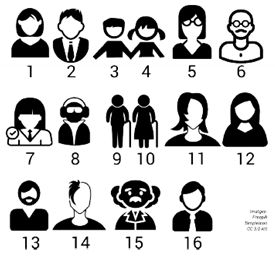
| 1 | 2 | 3 | 4 | 5 | 6 |
| 7 | 8 | 9 | 10 | 11 | 12 |
| 13 | 14 | 15 | 16 |
| Attitude towards science and technology | 1 | 2 | 3 | 4 |
| A1. The sciences at school are interesting. | ||||
| A2. The sciences at school are easy to learn. | ||||
| A3. I like the sciences more than other subjects. | ||||
| A4. What I learn in science classes helps me in my everyday life. | ||||
| A5. The sciences at school have made me more critical. | ||||
| A6. School science has increased my curiosity towards things that we still cannot explain. | ||||
| Opinion on science and technology | 1 | 2 | 3 | 4 |
| B1. Science and technology are important for society. | ||||
| B2. Thanks to science and technology, there will be greater opportunities for future generations. | ||||
| B3. Science and technology make our lives healthier, easier, and more comfortable. | ||||
| B4. The sciences at school have increased my respect for nature. | ||||
| B5. The sciences at school have taught me to take better care of my health. | ||||
| B6. New technologies will make work more interesting. | ||||
| B7. Scientists follow the scientific method, which always leads them to improve their responses. | ||||
| B8. We should always trust in what scientists have to say. | ||||
| B9. School science has shown me the importance of science for our way of life. | ||||
References
- García-Carmona, A.; Acevedo-Díaz, J.A. The nature of scientific practice and science education. Sci. Educ. 2018, 27, 435–455. [Google Scholar] [CrossRef]
- Ogunkola, B.J. Scientific literacy: Conceptual overview, importance and strategies for improvement. J. Educ. Soc. Res. 2013, 3, 265–274. [Google Scholar]
- Glaze, A.L. Teaching and learning science in the 21st century: Challenging critical assumptions in post-secondary science. Educ. Sci. 2018, 8, 12. [Google Scholar] [CrossRef]
- González-García, F.J.; Blanco-López, Á.; España-Ramos, E.; Franco-Mariscal, A.J. The Nature of Science and Citizenship: A Delphi Analysis. Res. Sci. Educ. 2019, 1–28. [Google Scholar] [CrossRef]
- Hodson, D. Nature of science in the science curriculum: Origin, development, implications and shifting emphases. In International Handbook of Research in History, Philosophy and Science Teaching; Springer: Dordrecht, The Netherlands, 2014; pp. 911–970. [Google Scholar] [CrossRef]
- Kemp, A.C. Science Educators’ Competing Views on the Goal of Scientific Literacy. Ph.D. Thesis, University of Georgia, Georgia, GA, USA, 2002. [Google Scholar]
- United Nations Statistics Division (UNSD). The Sustainable Development Goals Report 2017. Available online: https://unstats.un.org/sdgs/files/report/2017/TheSustainableDevelopmentGoalsReport2017.pdf (accessed on 13 February 2019).
- Braslavsky, B. ¿Primeras Letras o Primeras Lecturas? Fondo de Cultura Económica: Buenos Aires, Argentina, 2004. [Google Scholar]
- Gutiérrez, A.; Tyner, K. Media education, media literacy and digital competence. Comunicar 2012, 19, 31–39. [Google Scholar] [CrossRef]
- Pérsico, M.; Contín, S.A. What does it means to be literate nowadays? Comunicar 2005, 12, 177–182. [Google Scholar]
- García-Valcárcel, A.; Basilotta, V.; López, C. ICT in Collaborative Learning in the Classrooms of Primary and Secondary Education. Comunicar 2014, 21, 65–74. [Google Scholar] [CrossRef]
- Miller, J.D. The measurement of civic scientific literacy. Public Underst. Sci. 1998, 7, 203–223. [Google Scholar] [CrossRef]
- Pearson, P.D.; Moje, E.; Greenleaf, C. Literacy and science: Each in the service of the other. Science 2010, 328, 459–463. [Google Scholar] [CrossRef]
- DeBoer, G.E. Scientific literacy: Another look at its historical and contemporary meanings and its relationship to science education reform. J. Res. Sci. Teach. 2000, 37, 582–601. [Google Scholar] [CrossRef]
- Laugksch, R.C. Scientific literacy: A conceptual overview. Sci. Educ. 2000, 84, 71–94. [Google Scholar] [CrossRef]
- Hurd, P.D. Science literacy: Its meaning for American schools. Educ. Leadersh. 1958, 16, 13–16. [Google Scholar]
- Norris, S.P.; Phillips, L.M. How literacy in its fundamental sense is central to scientific literacy. Sci. Educ. 2003, 87, 224–240. [Google Scholar] [CrossRef]
- Fang, Z. Scientific literacy: A systemic functional linguistics perspective. Sci. Educ. 2005, 89, 335–347. [Google Scholar] [CrossRef]
- Hobson, A. The surprising effectiveness of college scientific literacy courses. Phys. Teach. 2008, 46, 404–406. [Google Scholar] [CrossRef][Green Version]
- OCDE. Assessing Scientific, Reading and Mathematical Literacy: A Framework for PISA 2006; OCDE Publishing: Paris, France, 2007. [Google Scholar]
- Bybee, R.; McCrae, B.; Laurie, R. PISA 2006. An assessment of scientific literacy. J. Res. Sci. Teach. 2009, 46, 865–883. [Google Scholar] [CrossRef]
- OCDE. PISA 2018 Results (Volume I): What Students Know and Can Do; OCDE Publishing: Paris, France, 2019. [Google Scholar] [CrossRef]
- National Research Council (NRC). National Science Education Standards; National Academies Press: Washington, DC, USA, 1996. [Google Scholar] [CrossRef]
- Holbrook, J.; Rannikmae, M. The meaning of scientific literacy. Int. J. Environ. Sci. Educ. 2009, 4, 275–288. [Google Scholar]
- Miller, J.D. Scientific literacy: A conceptual and empirical review. Daedalus 1983, 29–48. [Google Scholar]
- Roth, W.M.; Lee, S. Scientific literacy as collective praxis. Public Underst. Sci. 2016, 11, 33–56. [Google Scholar] [CrossRef]
- Martínez-Ruiz, F.J.; Bautista-Arnedo, M.M.; Del Pino-Ruiz, P. Scientific education, society and TV. Comunicar 2005, 13, 25. [Google Scholar] [CrossRef]
- Heigl, F.; Kieslinger, B.; Paul, K.T.; Uhlik, J.; Dörler, D. Opinion: Toward an international definition of citizen science. Proc. Natl. Acad. Sci. USA 2019, 116, 8089–8092. [Google Scholar] [CrossRef]
- Ramírez-Montoya, M.S.; García-Peñalvo, F.J. Co-creation and open innovation: Systematic literature review. Comunicar 2018, 54, 09–18. [Google Scholar] [CrossRef]
- Bell, R.L.; Lederman, N.G. Understandings of the nature of science and decision making on science and technology based issues. Sci. Educ. 2003, 87, 352–377. [Google Scholar] [CrossRef]
- COSCE. Informe ENCIENDE.; Editorial Rubes: Barcelona, Spain, 2011. [Google Scholar]
- Catlin-Groves, C.L. The citizen science landscape: From volunteers to citizen sensors and beyond. Int. J. Zool. 2012, 2012. [Google Scholar] [CrossRef]
- Curtis, V. Online Citizen Science and the Widening of Academia; Palgrave Macmillan: Cham, Switzerland, 2018. [Google Scholar] [CrossRef]
- Land-Zandstra, A.M.; Devilee, J.L.; Snik, F.; Buurmeijer, F.; van den Broek, J.M. Citizen science on a smartphone: Participants’ motivations and learning. Public Underst. Sci. 2016, 25, 45–60. [Google Scholar] [CrossRef]
- Pocock, M.J.; Roy, H.E.; August, T.; Kuria, A.; Barasa, F.; Bett, J.; Githiru, M.; Kairo, J.; Kimani, J.; Kinuthia, W.; et al. Developing the global potential of citizen science: Assessing opportunities that benefit people, society and the environment in East Africa. J. Appl. Ecol. 2019, 56, 274–281. [Google Scholar] [CrossRef]
- Irwin, A. Citizen Science; Routledge: London, UK, 2002. [Google Scholar] [CrossRef]
- Ottinger, G. Buckets of resistance: Standards and the effectiveness of citizen science. Sci. Technol. Hum. Values 2010, 35, 244–270. [Google Scholar] [CrossRef]
- Crall, A.W.; Jordan, R.; Holfelder, K.; Newman, G.J.; Graham, J.; Waller, D.M. The impacts of an invasive species citizen science training program on participant attitudes, behavior, and science literacy. Public Underst. Sci. 2013, 22, 745–764. [Google Scholar] [CrossRef]
- Riesch, H.; Potter, C. Citizen science as seen by scientists: Methodological, epistemological and ethical dimensions. Public Underst. Sci. 2014, 23, 107–120. [Google Scholar] [CrossRef]
- Ruiz-Mallén, I.; Riboli-Sasco, L.; Ribrault, C.; Heras, M.; Laguna, D.; Perié, L. Citizen science: Toward transformative learning. Sci. Commun. 2016, 38, 523–534. [Google Scholar] [CrossRef]
- Bonney, R.; Phillips, T.B.; Ballard, H.L.; Enck, J.W. Can citizen science enhance public understanding of science? Public Underst. Sci. 2016, 25, 2–16. [Google Scholar] [CrossRef] [PubMed]
- Kharrazi, A.; Qin, H.; Zhang, Y. Urban big data and sustainable development goals: Challenges and opportunities. Sustainability 2016, 8, 1293. [Google Scholar] [CrossRef]
- Gadermaier, G.; Dörler, D.; Heigl, F.; Mayr, S.; Rüdisser, J.; Brodschneider, R.; Marizzi, C. Peer-reviewed publishing of results from Citizen Science projects. J. Sci. Commun. 2018, 17, 1–5. [Google Scholar] [CrossRef]
- Burgess, H.K.; DeBey, L.B.; Froehlich, H.E.; Schmidt, N.; Theobald, E.J.; Ettinger, A.K.; HilleRisLambers, J.; Tewksbury, J.; Parrish, J.K. The science of citizen science: Exploring barriers to use as a primary research tool. Biol. Conserv. 2017, 208, 113–120. [Google Scholar] [CrossRef]
- Bonney, R.; Cooper, C.B.; Dickinson, J.; Kelling, S.; Phillips, T.; Rosenberg, K.V.; Shirk, J. Citizen science: A developing tool for expanding science knowledge and scientific literacy. BioScience 2009, 59, 977–984. [Google Scholar] [CrossRef]
- The Sustainable Development Goals Report 2019. Available online: https://unstats.un.org/sdgs/report/2019/The-Sustainable-Development-Goals-Report-2019.pdf (accessed on 13 February 2019).
- Transforming Our World: The 2030 Agenda for Sustainable Development. Available online: https://sustainabledevelopment.un.org/post2015/transformingourworld (accessed on 13 February 2020).
- Fritz, S.; See, L.; Carlson, T.; Haklay, M.M.; Oliver, J.L.; Fraisl, D.; Mondardini, R.; Brocklehurst, M.; Shanley, L.A.; Schade, S.; et al. Citizen science and the United Nations Sustainable Development Goals. Nat. Sustain. 2019, 2, 922–930. [Google Scholar] [CrossRef]
- Lu, Y.; Nakicenovic, N.; Visbeck, M.; Stevance, A.S. Policy: Five priorities for the UN sustainable development goals. Nature 2015, 520, 432–433. [Google Scholar] [CrossRef]
- UNESCO. Education for Sustainable Development Goals; Learning Objectives; UNESCO: Paris, France, 2017. [Google Scholar]
- Eizaguirre, A.; García-Feijoo, M.; Laka, J.P. Defining sustainability core competencies in business and management studies based on multinational stakeholders’ perceptions. Sustainability 2019, 11, 2303. [Google Scholar] [CrossRef]
- Arias, R.; Queiruga-Dios, M.A.; Pelacho, M. Unidad Didáctica Odour Collect; Editorial Q: A Coruña, Spain, 2019. [Google Scholar]
- Diez-Ojeda, M.; Cordeiro-Bizerra, A.M.; Queiruga-Dios, M.A.; Bruno-Collados, D.; Ibáñez-Hernández, M.C. Unidad Didáctica Vigilantes del Aire. Ciencia Ciudadana para Monitorizar la Calidad del Aire; Editorial Q: A Coruña, Spain, 2019. [Google Scholar]
- López-Redondo, M.; Queiruga-Dios, M.A.; Sáiz-Manzanares, M.C.; Juez-Navarro, S. Citizen Science in School. In Hands-on Science: Advancing Science, Improving Education; Associação Hands-on Science Network: Barcelona, Spain, 2018; pp. 194–198. [Google Scholar]
- Iber Aqua Project. Available online: https://aqua.ibercivis.es/#!/project (accessed on 13 February 2019).
- SDG Indicators. United Nations Global SDG Database. Available online: https://unstats.un.org/sdgs/indicators/database/ (accessed on 14 March 2020).
- Sarah West, S.; Pateman, R. How Could Citizen Science Support the Sustainable Development Goals? Policy Brief; Stockholm Environment Institute: Stockholm, Sweden, 2017. [Google Scholar]
- RecerCaixa. Impacte de la Introducció de la Ciència Ciutadana a les Escoles; Fundación La Caixa: Barcelona, Spain, 2016. [Google Scholar]
- Sjøberg, S.; Schreiner, C. How do learners in different cultures relate to science and technology? Results and perspectives from the project ROSE (the Relevance of Science Education). Asia-Pac. Forum Sci. Learn. Teach. 2005, 6, 1–17. [Google Scholar]
- Iber Aqua App. Available online: https://play.google.com/store/apps/details?id=ibercivis.com.iberaquav2&hl=en_US (accessed on 13 February 2019).
- Real Decreto 1105/2014, de 26 de diciembre, por el que se establece el currículo básico de la Educación Secundaria Obligatoria y del Bachillerato. Boletín Oficial del Estado, 37. de 3 de enero de 2015, 169 a 546. Available online: http://bit.ly/36eKHus (accessed on 13 February 2019).
- Eurydice. Key Data on Teaching Languages at School in Europe. Bruss. Eurydice 2017. [Google Scholar] [CrossRef]
- National Research Council (NRC). How People Learn: Brain, Mind, Experience, and School: Expanded Edition; National Academies Press: Washington, DC, USA, 2000. [Google Scholar] [CrossRef]
- Cohen, J. A power primer. Psychol. Bull. 1992, 112, 155. [Google Scholar] [CrossRef] [PubMed]
- Morrison, J.A.; Raab, F.; Ingram, D. Factors influencing elementary and secondary teachers’ views on the nature of science. J. Res. Sci. Teach. 2009, 46, 384–403. [Google Scholar] [CrossRef]
- García-Carmona, A.; Acevedo-Díaz, J.A. Understanding the Nature of Science Through a Critical and Reflective Analysis of the Controversy Between Pasteur and Liebig on Fermentation. Sci. Educ. 2017, 26, 65–91. [Google Scholar] [CrossRef]
- Senabre, E.; Ferran-Ferrer, N.; Perelló, J. Participatory design of citizen science experiments. Comunicar 2018, 26, 29–38. [Google Scholar] [CrossRef]
- Fox, O.; Stoett, P. Citizen participation in the UN Sustainable Development Goals consultation process: Toward global democratic governance. Glob. Gov. 2016, 22, 555–574. [Google Scholar] [CrossRef]
- Vitone, T.; Stofer, K.; Steininger, M.S.; Hulcr, J.; Dunn, R.; Lucky, A. School of ants goes to college: Integrating citizen science into the general education classroom increases engagement with science. J. Sci. Commun. 2016, 15, A03. [Google Scholar] [CrossRef]
- Fraisl, D.; Fritz, S.; See, L.; McCallum, I.; Moorthy, I. Citizen Science & SDGs: Opportunities, Challenges, Recommendations. In Proceedings of the Eye on Earth Summit, Dubai, UAE, 22–24 October 2018. [Google Scholar]
- Hajer, M.; Nilsson, M.; Raworth, K.; Bakker, P.; Berkhout, F.; De Boer, Y.; Rockström, J.; Ludwig, K.; Kok, M. Beyond cockpit-ism: Four insights to enhance the transformative potential of the sustainable development goals. Sustainability 2015, 7, 1651–1660. [Google Scholar] [CrossRef]
- About the Sustainable Development Goals. Available online: https://www.un.org/sustainabledevelopment/sustainable-development-goals (accessed on 25 February 2020).
- Evans, C.; Abrams, E.; Reitsma, R.; Roux, K.; Salmonsen, L.; Marra, P.P. The Neighborhood Nestwatch Program: Participant outcomes of a citizen-science ecological research project. Conserv. Biol. 2005, 19, 589–594. [Google Scholar] [CrossRef]
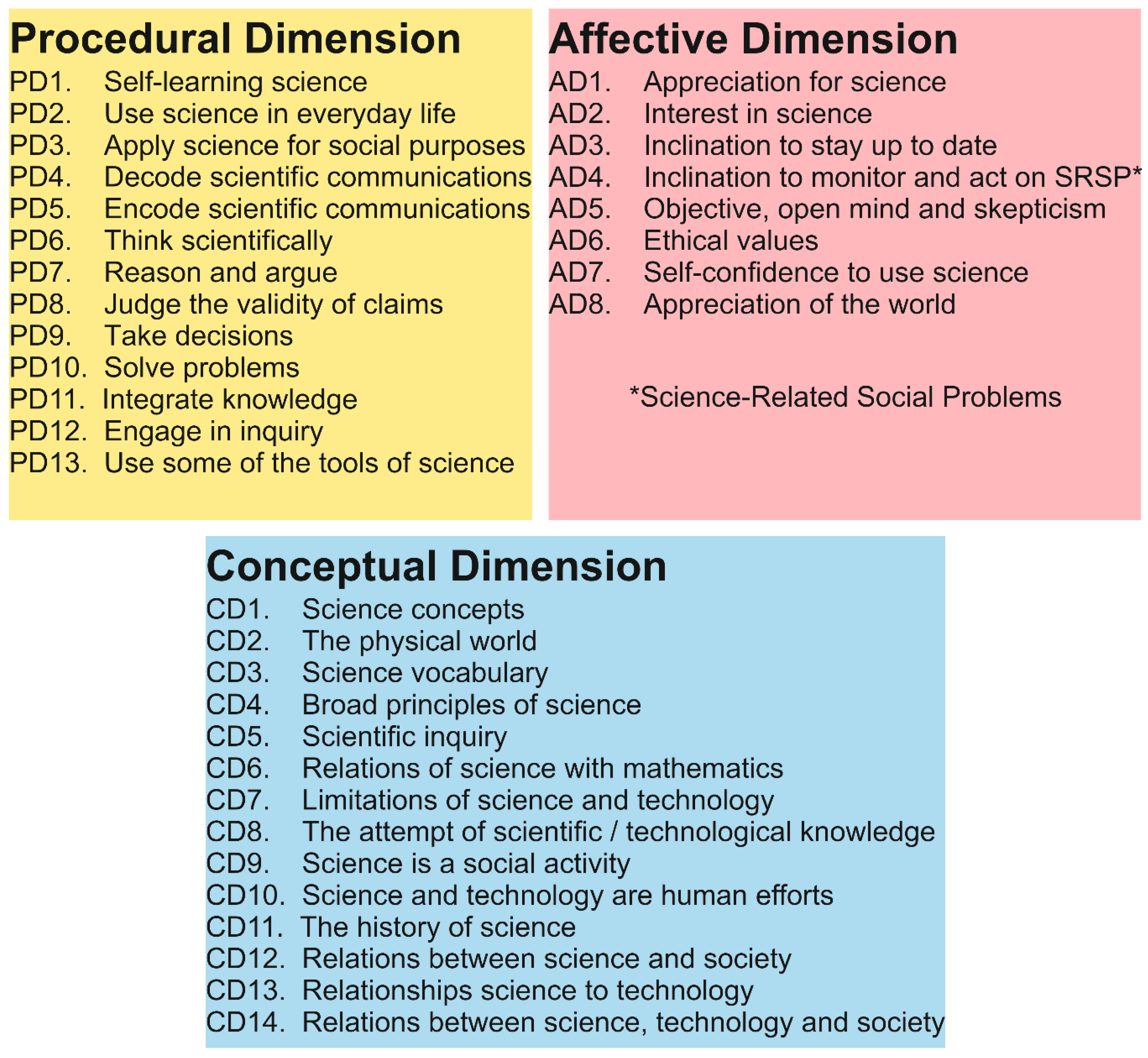
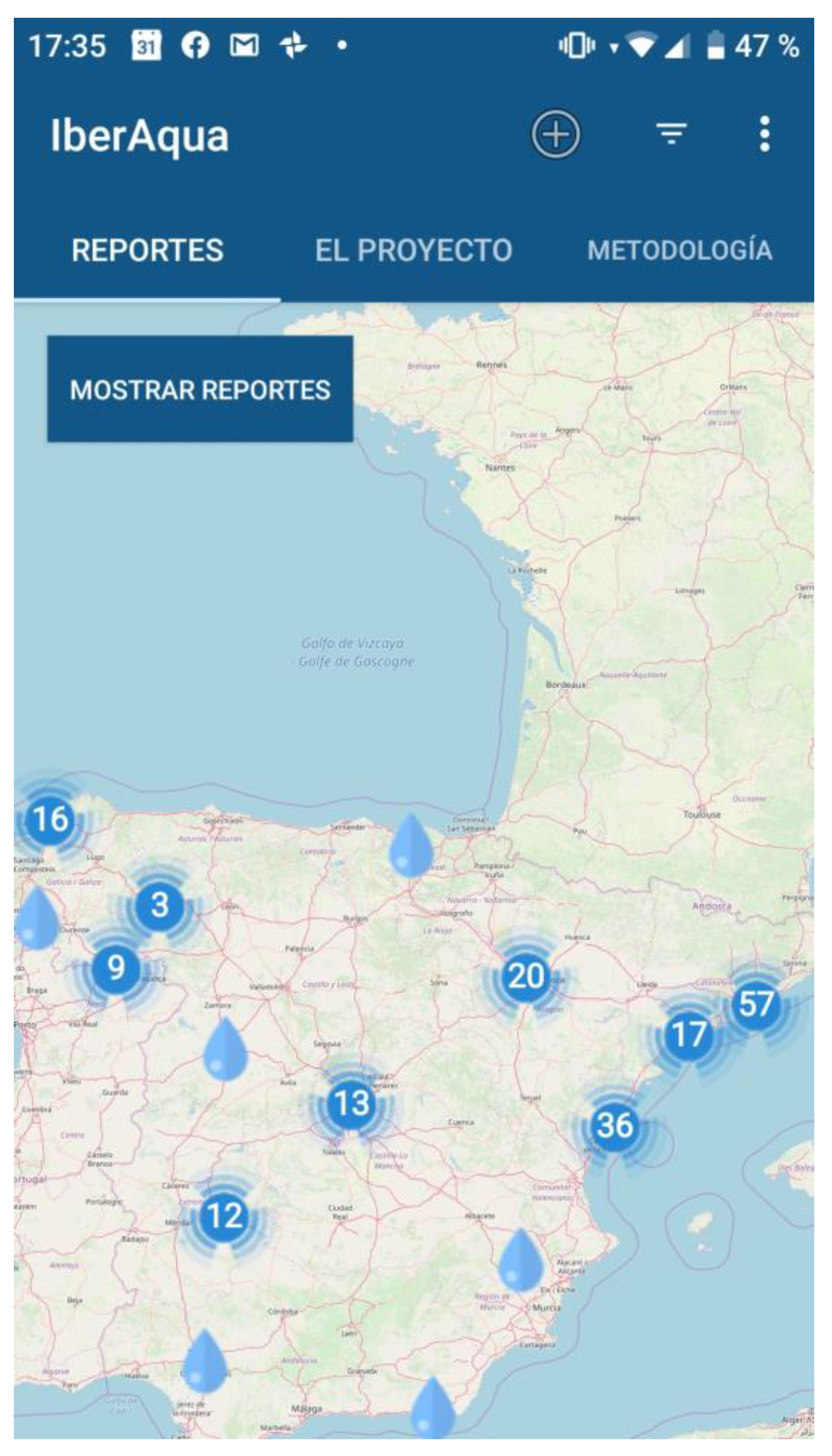
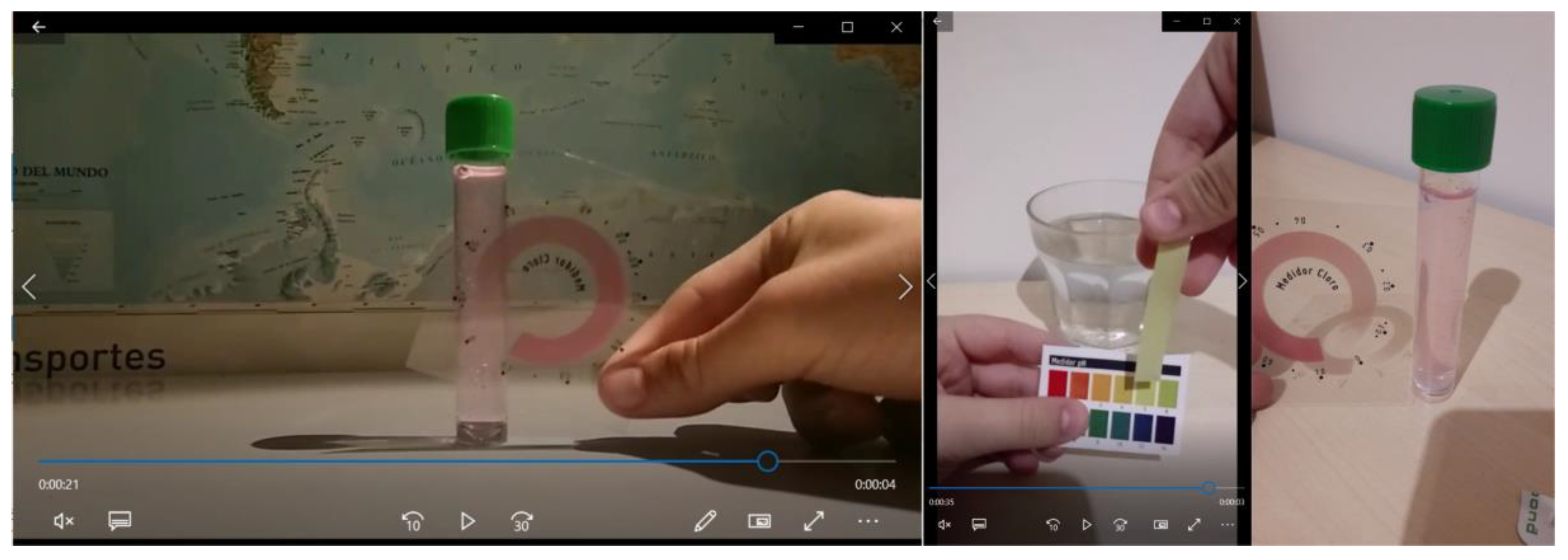
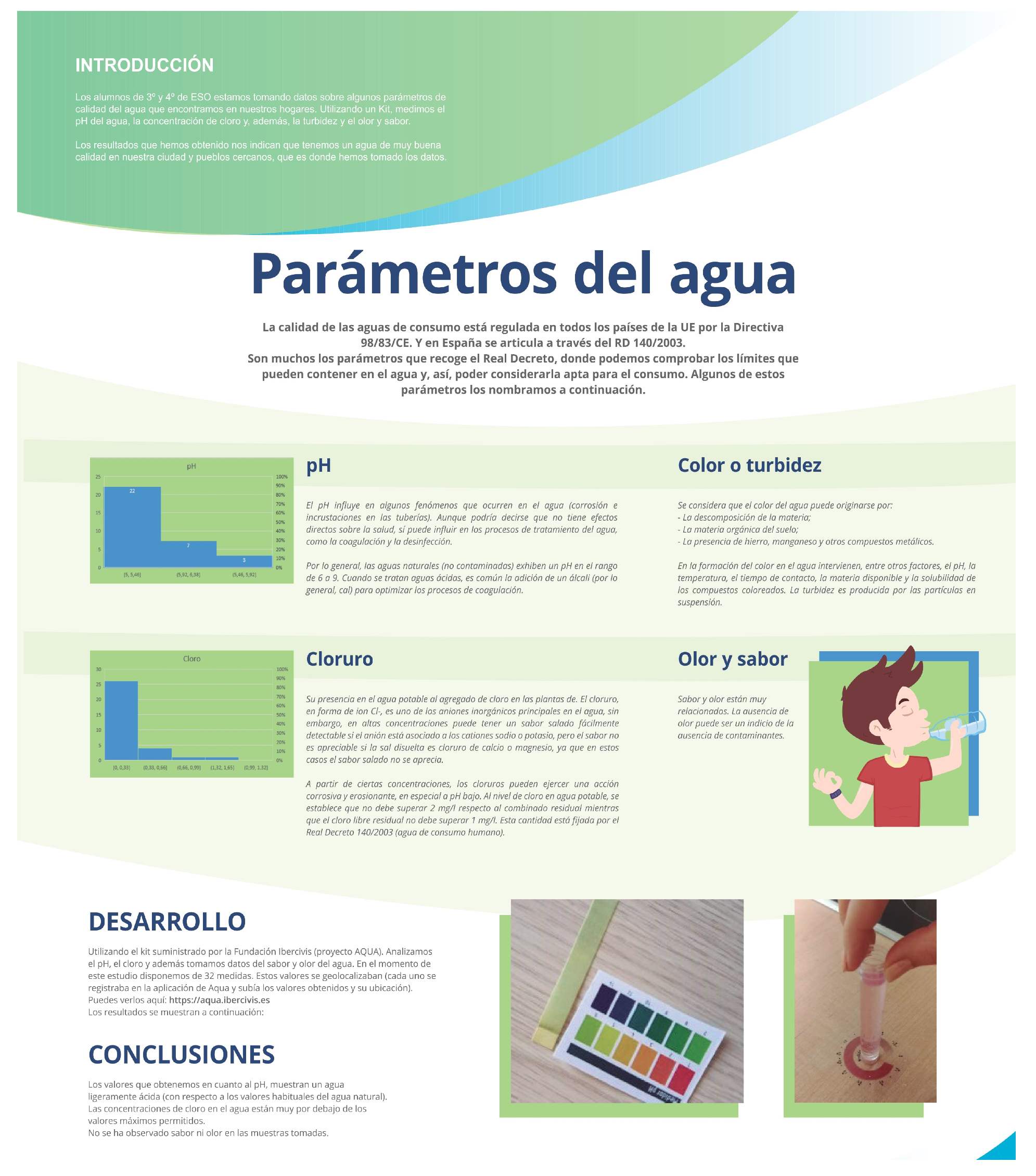
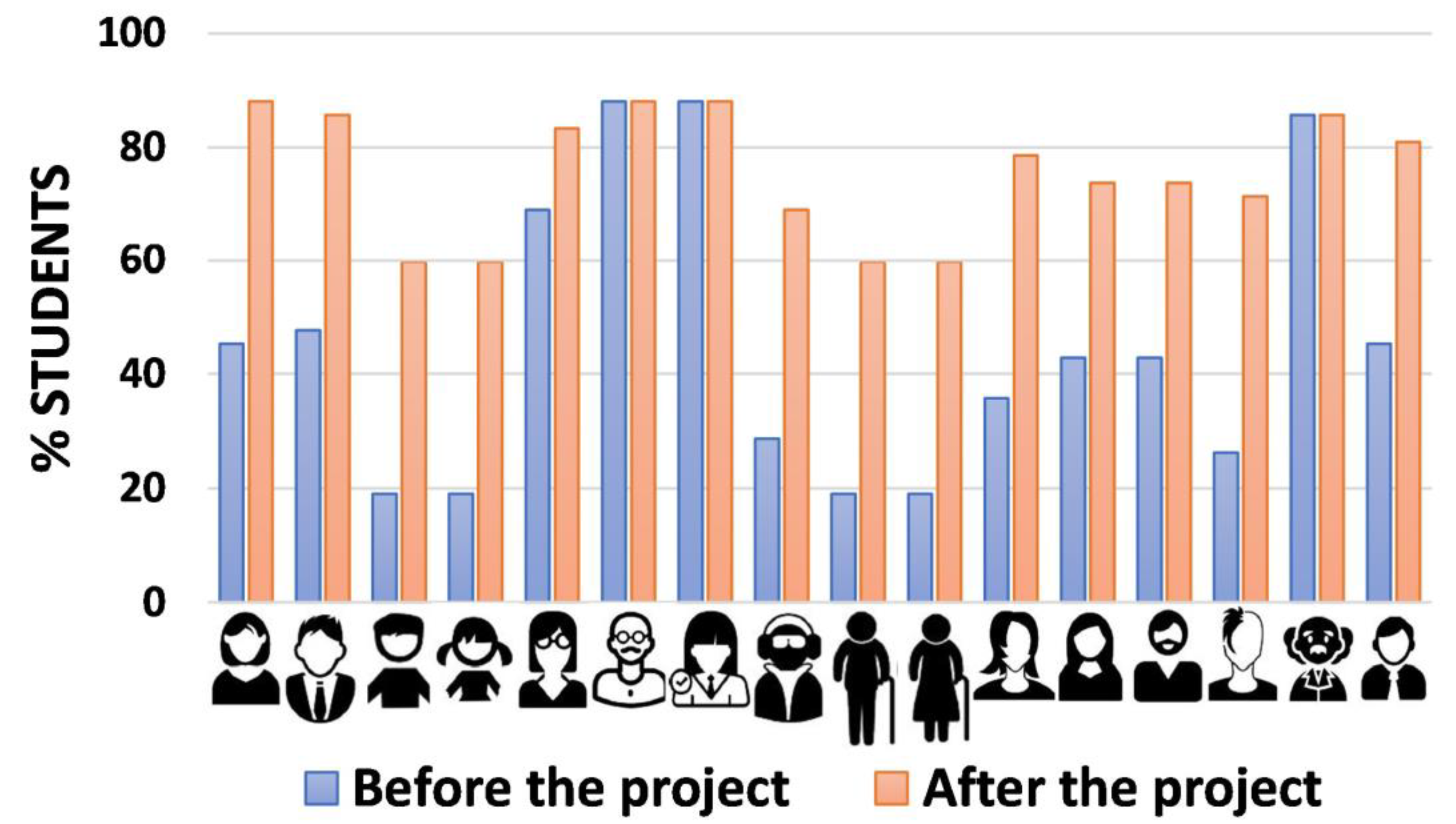
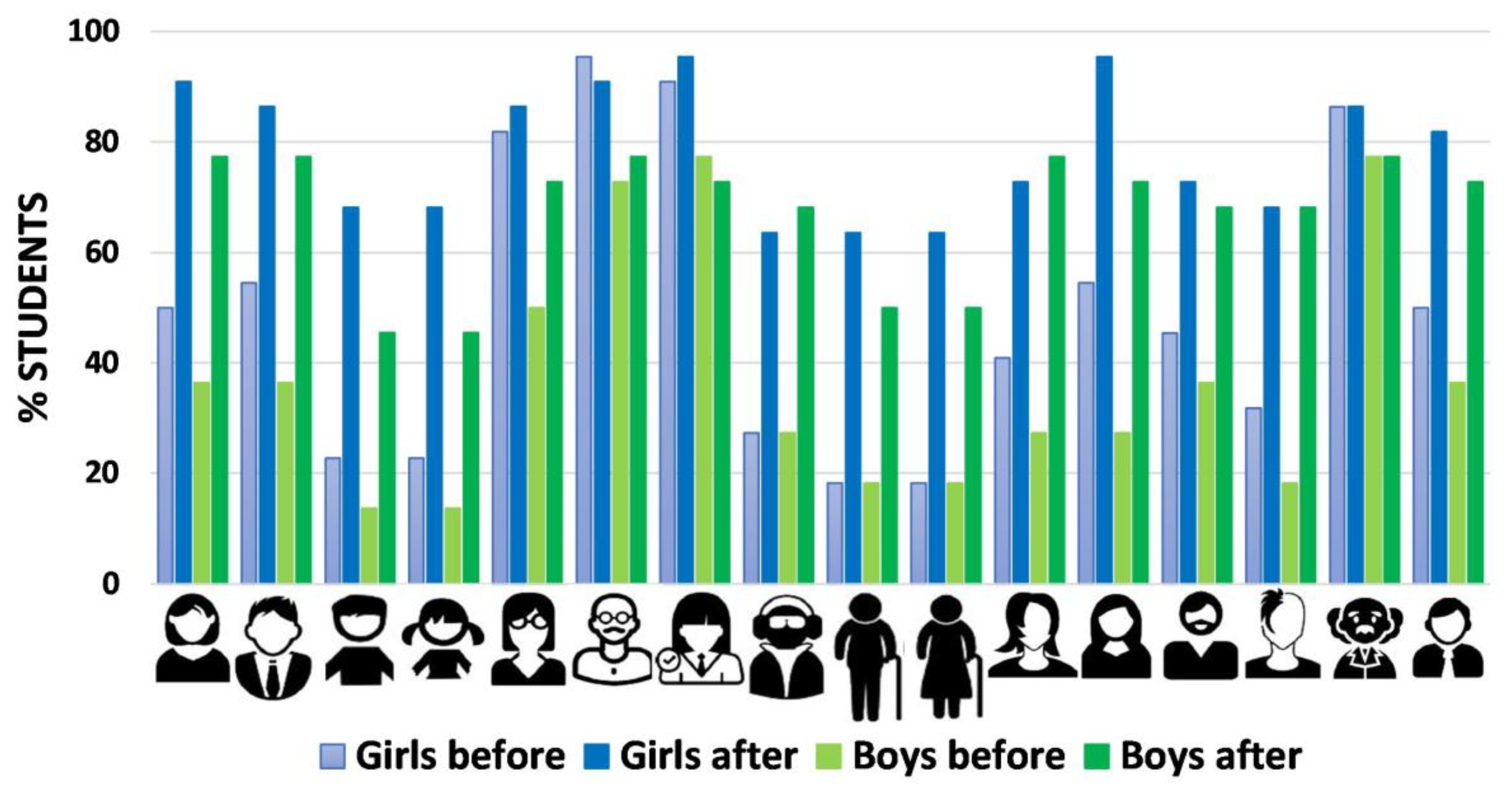
| Total | Girls | Boys | |||||||||||||
|---|---|---|---|---|---|---|---|---|---|---|---|---|---|---|---|
| Before | After | Before | After | Before | After | ||||||||||
| Question | M | SD | M | SD | d | M | SD | M | SD | d | M | SD | M | SD | d |
| A1 | 2.77 | 0.75 | 3.52 | 0.70 | 1.03 | 2.67 | 0.77 | 3.43 | 0.82 | 0.96 | 2.91 | 0.71 | 3.65 | 0.49 | 1.21 |
| A2 | 2.46 | 0.95 | 3.07 | 0.85 | 0.68 | 2.27 | 0.93 | 2.98 | 0.88 | 0.78 | 2.74 | 0.93 | 3.21 | 0.81 | 0.54 |
| A3 | 2.54 | 1.12 | 3.00 | 0.95 | 0.44 | 2.45 | 1.06 | 2.94 | 0.99 | 0.48 | 2.68 | 1.20 | 3.09 | 0.90 | 0.39 |
| A4 | 2.24 | 0.91 | 3.37 | 0.64 | 1.44 | 2.16 | 0.85 | 3.43 | 0.61 | 1.72 | 2.35 | 0.98 | 3.29 | 0.68 | 1.11 |
| A5 | 2.16 | 0.96 | 2.94 | 0.93 | 0.83 | 2.16 | 0.94 | 2.94 | 0.88 | 0.86 | 2.15 | 0.99 | 2.94 | 1.01 | 0.79 |
| A6 | 2.07 | 0.99 | 3.18 | 0.83 | 1.22 | 2.00 | 1.00 | 3.16 | 0.83 | 1.26 | 2.18 | 0.97 | 3.21 | 0.84 | 1.14 |
| Total | Girls | Boys | |||||||||||||
|---|---|---|---|---|---|---|---|---|---|---|---|---|---|---|---|
| Before | After | Before | After | Before | After | ||||||||||
| Question | M | SD | M | SD | d | M | SD | M | SD | d | M | SD | M | SD | d |
| B1 | 2.90 | 0.76 | 3.51 | 0.61 | 0.89 | 2.86 | 0.68 | 3.45 | 0.61 | 0.91 | 2.97 | 0.87 | 3.59 | 0.61 | 0.83 |
| B2 | 2.89 | 0.77 | 3.55 | 0.52 | 1.01 | 2.90 | 0.68 | 3.49 | 0.54 | 0.96 | 2.88 | 0.88 | 3.65 | 0.49 | 1.08 |
| B3 | 2.49 | 0.93 | 3.36 | 0.71 | 1.05 | 2.41 | 0.93 | 3.35 | 0.66 | 1.17 | 2.62 | 0.92 | 3.38 | 0.78 | 0.89 |
| B4 | 2.07 | 0.99 | 3.18 | 0.83 | 1.22 | 2.63 | 0.83 | 3.39 | 0.67 | 1.01 | 2.79 | 0.64 | 3.32 | 0.59 | 0.86 |
| B5 | 2.57 | 0.97 | 3.41 | 0.75 | 0.97 | 2.41 | 1.00 | 3.37 | 0.83 | 1.05 | 2.79 | 0.88 | 3.47 | 0.61 | 0.90 |
| B6 | 2.71 | 0.77 | 3.64 | 0.51 | 1.42 | 2.55 | 0.65 | 3.67 | 0.47 | 1.98 | 2.94 | 0.89 | 3.59 | 0.56 | 0.87 |
| B7 | 2.45 | 0.87 | 3.42 | 0.77 | 1.18 | 2.33 | 0.83 | 3.35 | 0.78 | 1.27 | 2.62 | 0.92 | 3.53 | 0.75 | 1.08 |
| B8 | 2.53 | 0.89 | 3.45 | 0.63 | 1.19 | 2.47 | 0.84 | 3.37 | 0.64 | 1.21 | 2.62 | 0.95 | 3.56 | 0.61 | 1.18 |
| B9 | 2.40 | 0.83 | 3.54 | 0.65 | 1.53 | 2.31 | 0.80 | 3.55 | 0.68 | 1.67 | 2.53 | 0.86 | 3.53 | 0.61 | 1.34 |
© 2020 by the authors. Licensee MDPI, Basel, Switzerland. This article is an open access article distributed under the terms and conditions of the Creative Commons Attribution (CC BY) license (http://creativecommons.org/licenses/by/4.0/).
Share and Cite
Queiruga-Dios, M.Á.; López-Iñesta, E.; Diez-Ojeda, M.; Sáiz-Manzanares, M.C.; Vázquez Dorrío, J.B. Citizen Science for Scientific Literacy and the Attainment of Sustainable Development Goals in Formal Education. Sustainability 2020, 12, 4283. https://doi.org/10.3390/su12104283
Queiruga-Dios MÁ, López-Iñesta E, Diez-Ojeda M, Sáiz-Manzanares MC, Vázquez Dorrío JB. Citizen Science for Scientific Literacy and the Attainment of Sustainable Development Goals in Formal Education. Sustainability. 2020; 12(10):4283. https://doi.org/10.3390/su12104283
Chicago/Turabian StyleQueiruga-Dios, Miguel Ángel, Emilia López-Iñesta, María Diez-Ojeda, María Consuelo Sáiz-Manzanares, and José Benito Vázquez Dorrío. 2020. "Citizen Science for Scientific Literacy and the Attainment of Sustainable Development Goals in Formal Education" Sustainability 12, no. 10: 4283. https://doi.org/10.3390/su12104283
APA StyleQueiruga-Dios, M. Á., López-Iñesta, E., Diez-Ojeda, M., Sáiz-Manzanares, M. C., & Vázquez Dorrío, J. B. (2020). Citizen Science for Scientific Literacy and the Attainment of Sustainable Development Goals in Formal Education. Sustainability, 12(10), 4283. https://doi.org/10.3390/su12104283









